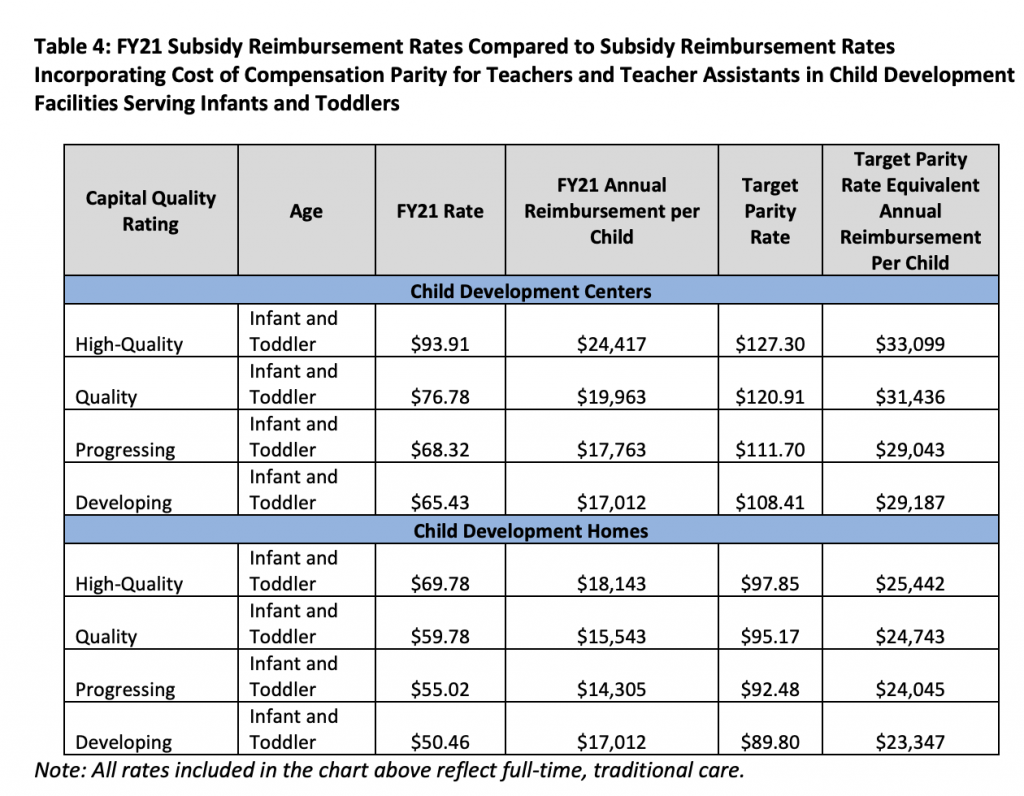DC’s Education Superintendent Confirms Big Price Hikes from Dem Child Care Plan
A couple of weeks ago, I
wrote a piece pointing out that the Democrats’ child care plan would hugely increase costs, e.g. by $13,000 for infant care, for unsubsidized parents. This generated a very negative and mostly unspecific reaction from child care advocates that varied between saying I was wrong without saying exactly that or saying it’s not politically wise to talk about such things right now (
I,
II).
Today, the District of Columbia’s Office of the State Superintendent of Education (DC OSSE) released a
report about a DC child care proposal that reaches the exact same conclusion that I did.
Cost Hikes
In 2018, the DC government passed the Birth-to-Three for All DC Act, which, among other things, directed the OSSE to analyze what would happen if the city required child care workers to receive “compensation equivalent to an elementary school teacher employed by the District of Columbia Public Schools (DCPS) with the equivalent role, credentials, and experience.”
Nearly identical language, probably written by the exact same people, is found in the Build Back Better (BBB) child care plan currently being debated in Congress. That language requires states to ensure that child care worker wages “are equivalent to wages for elementary educators with similar credentials and experience in the State.”
Using a very detailed cost estimate model, which incorporates data directly from providers, OSSE concluded that the per-child cost of providing center-based toddler and infant care would increase by about $12,000 in most centers. In centers that are already considered high-quality, the cost would increase by about $9,000.
When digesting these numbers, it’s important to note that the DC minimum wage is currently $15.20 per hour, which is 25 percent
higher than the national median child care worker wage of $12.24. Areas where child care wages are currently lower than that would likely to see costs grow by a higher amount.
The OSSE analysis also includes infant and toddler care together in its averages. In general, infant care would increase by more than the average amount while toddler care would increase by less.
Finally, the OSSE analysis only analyzes pay increases for direct child care staff, ignoring any spillover effects that these increases would have on the wages of center directors and similar staff. This approach likely understates how much costs would rise, according to the OSSE:
This estimated cost also does not include the costs of increasing compensation for other staff in child development facilities serving infants and toddlers, such as center directors or preschool teachers, because the Birth-to-Three for All DC Act does not address compensation for these staff. However, facilities that increased compensation for infant and toddler teachers and assistants would likely need to increase compensation for these staff as well, which would further increase the costs for child care providers.
No matter how you cut it, it’s clear enough that this kind of mandate is going to cause the unsubsidized cost of child care to increase dramatically, just as I said a couple of weeks ago.
Unsubsidized Parents Get Hit
Increasing child care worker wages while also subsidizing the cost for parents is potentially a big win-win for everyone involved. But the current BBB child care plan only subsidizes costs for parents with incomes below a certain threshold, as outlined in the table below.
Year Eligible Incomes as Percent of State Median Income
2022 Below 100%
2023 Below 125%
2024 Below 150%
2025 Below 250%
2026 Below 250%
2027 Below 250%
Families with incomes below these levels will receive subsidies that ensure they don’t have to pay the increased costs that will result from the increased child care demand and the wage, quality, and credential mandates contained in the legislation. Families with incomes above these levels will have to pay the full child care price, which will be massively higher than it was before.
The OSSE explains the problem with this model very well.
Forty-nine percent of child development centers participating in [the subsidy system] have fewer than half of their seats occupied by children receiving subsidies, as do 45 percent of homes. Because increasing staff compensation would increase the costs to deliver care for both subsidy and non-subsidy children, these child development facilities would need to either raise parent tuition payments or identify additional revenue sources to cover the increased costs to deliver care to non-subsidy children.





